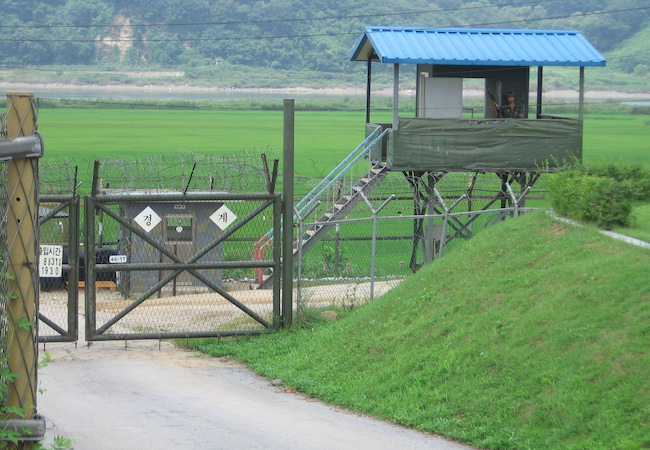Korean Tensions: Could They Slip out of Control?
TRANSCEND MEMBERS, 8 May 2017
Rene Wadlow – TRANSCEND Media Service

A South Korean sentry near the demilitarized zone (Imjingang)
(Photo: By Johannes Barre. Courtesy of WikiCommons)
8 May 2017 – There have been over the years since the 1953 armistice periodic increases of tensions related to the policies of the Democratic People’s Republic of Korea (North Korea) and the Republic of Korea (South Korea). Currently, the nuclear program and missile launches of North Korea, the establishment of sophisticated anti-missile systems in South Korea, increased sanctions against North Korea voted by the United Nations Security Council as well as a new administration in Washington has led to an escalation of tensions. While tensions in the past have been managed by diplomatic discussions or changes in policy, there are always dangers that conflict management may fail due to miscalculations, misinterpretations of military moves, misinterpretations of aims and strategies. The misinterpretations and the failures of conflict management were important factors in the start of the Korean War in 1950 as well as the intervention of Chinese “volunteer” troops. [1]
Today, we are at a time when crisis triggers are ready. Crisis triggers are actions which occur prior to the onset of overt physical hostility between adversary States. Fortunately, not all triggers are pulled. Yet we must ask ourselves if the current tensions could slip out of the control of conflict management techniques.
It is difficult to predict events or to know what can be helpful in the current situation. Some international relations specialists, such as Morton Kaplan hold that it is extremely difficult if not impossible to predict single events. [2]
There have been efforts within the U.N. system to analyze the nature of crisis triggers, the likelihood of violence breaking out, and the type of mediation and preventive diplomacy which could be carried out. [3]
For Korea, certain “rules of the game” of conflict management have been worked out. Rules of the game constitute a framework for standards of behavior which maintain restraint, unless there is a breakdown or serious miscalculation. There needs to be some degree of common interest among the parties which makes possible the development of these rules of the game for conflict management. The Chinese government has been calling for restraint and warning that the rules of the game may not hold. “The United States and South Korea and North Korea are engaging in tit for tat, with swords drawn and bows bent, and there have been storm clouds gathering.” China’s Foreign Minister, Wang Yi has been quoted by the Chinese Press Agency Xinh. Objectively, a lowering of tensions and a return to the status quo ante should be possible. But objective conditions do not always keep the rules of the game in place. In 1909 R. Norman Angell published his bestseller The Great Illusion: A Study of the Relation of Military Power in Nations to their Economic and Social Advantage. He set out the evidence that wars would no longer occur in Europe as they did not make economic sense. The rules of the game among European Powers put into place in 1815 at the end of the wars of Napoleon were holding and had facilitated an international and relatively prosperous economy. Europe is now marking the 100th anniversary of some of the major battles of the 1914-1918 War.
After the 1990 end of the Cold War, efforts for the mutual benefit from economic efforts were strengthened by the establishment of diplomatic relations between Beijing and Seoul in 1992. A large number of South Korean, Japanese and Taiwanese companies have invested in China which is a major trading partner for all the regional countries. However, the institutional framework required for regional integration is still missing. There is neither regional free-trade agreement nor a security framework such as the Organization for Security and Cooperation in Europe provided for the 1975-1990 Cold War period and continues today.
Today, the tensions around the two Korean States, the USA, China, Russia, and Japan are somewhat like the pre-1975 Helsinki period when tensions between NATO and the Warsaw Treaty Powers periodically rose, fell and rose again. Certain rules of the game had been set but were not formalized in treaties. Tensions but also conflict management were largely US-USSR affairs. Other countries in Europe were on the sidelines. Neutrals such as Finland, Sweden and Switzerland were largely ignored.
During the prelude period leading to the 1975 Helsinki Conference there were useful unofficial contacts among non-governmental organizations and academics – what is now called “Track II processes.” These contacts and exchanges of publications helped pave the way for later governmental negotiations. As changes took place, especially in the USSR and Eastern Europe, we later found people we knew in Track II efforts in official positions.
It is not clear to me what Track II efforts are possible concerning the Koran tensions and how open participants can be, especially those from the Korean States. The nuclear-missile issues may be beyond what Track II effort can usefully undertake. However, issues of energy, food, the environment and trade – often now called “human security issues” could be undertaken with benefit.
Track II initiatives must include persons from the two Korean States, the USA, China, Russia and Japan. However, other may take the initiative of organizing the Track II meetings. Pope Francis on his recent return from Egypt called attention to the dangers of the Korean tensions. Thus it may be that some Catholic institutions could take a lead.
Today, there are both anticipated and unanticipated dangers. There can also be avenues for cooperation. Leadership is crucial. As with the 1975 Helsinki Conference, Track II leadership may be an important factor in highlighting shared stability concerns and a strengthening of the rules of the game. [4]
Notes:
- Glenn D. Paige. The Korean Decision, June 24-30 1950 (New York: The Free Press, 1968) and Allen S. Whiting. China Crosses the Yalu. The Decision to Enter the Korean War (New York: McMillan Co; 1960)
- Morton A. Kaplan. System and Processes in International Politics (New York: John Wiley, 1957) and Charles E. Hermann.International Crises Insights from Behavioral Research (New York: The Free Press, 1972)
- Frank Edmead. Analysis and Prediction in International Mediation (New York: U.N. Institute for Training and Research, 1971)
- For a good overview of Track II efforts in different parts of the world, see Oliver P. Richmond and Henry F. Carsey (Eds.). Subcontracting Peace: The Challenges of NGO Peacebuilding (Aldershot: Ashgate Publishing, 2005)
_____________________________________
 René Wadlow, a member of the Fellowship of Reconciliation and of its Task Force on the Middle East, is president and U.N. representative (Geneva) of the Association of World Citizens and editor of Transnational Perspectives. He is a member of the TRANSCEND Network for Peace, Development and Environment.
René Wadlow, a member of the Fellowship of Reconciliation and of its Task Force on the Middle East, is president and U.N. representative (Geneva) of the Association of World Citizens and editor of Transnational Perspectives. He is a member of the TRANSCEND Network for Peace, Development and Environment.
This article originally appeared on Transcend Media Service (TMS) on 8 May 2017.
Anticopyright: Editorials and articles originated on TMS may be freely reprinted, disseminated, translated and used as background material, provided an acknowledgement and link to the source, TMS: Korean Tensions: Could They Slip out of Control?, is included. Thank you.
If you enjoyed this article, please donate to TMS to join the growing list of TMS Supporters.

This work is licensed under a CC BY-NC 4.0 License.